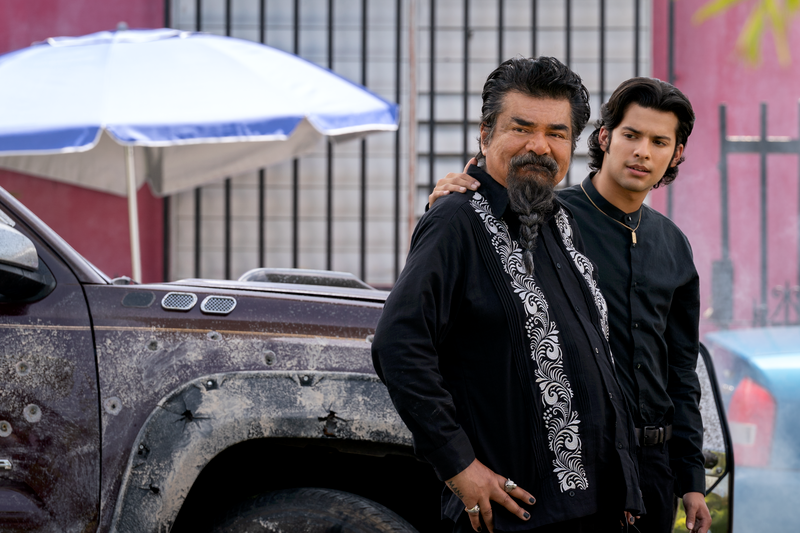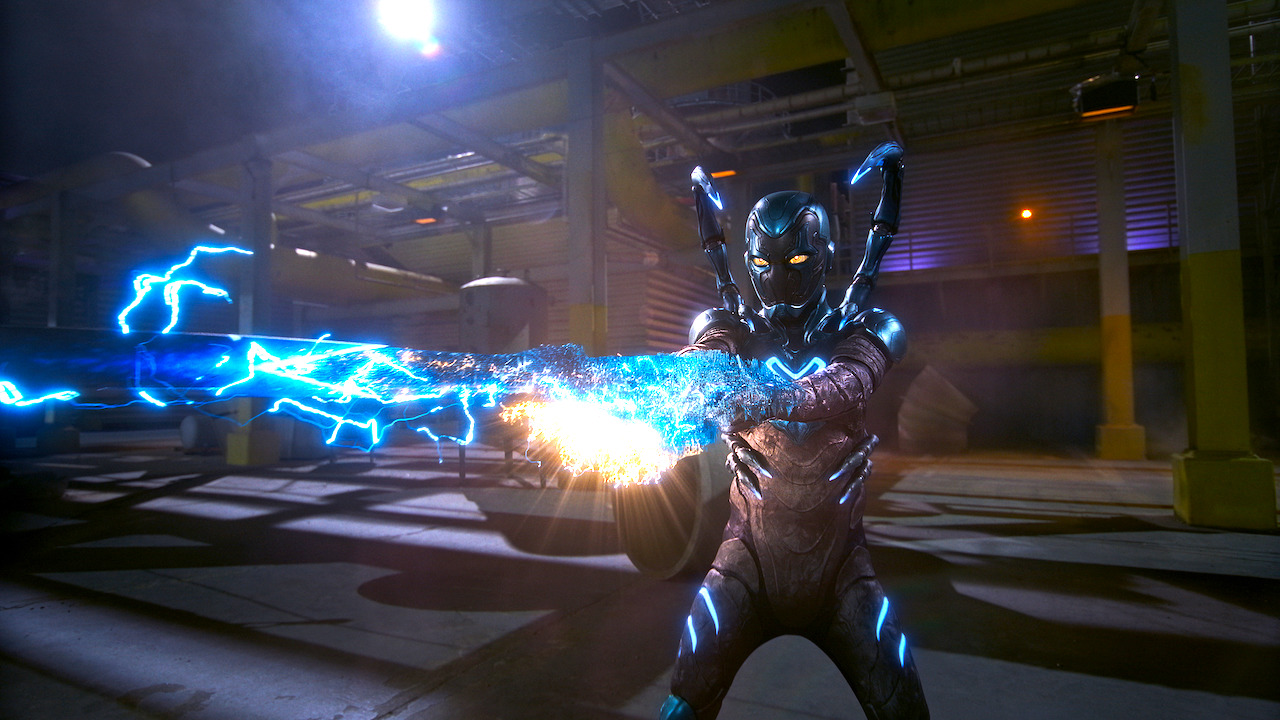This interview contains spoilers.
“I first became attached to Blue Beetle in 2018 through producers Zev Foreman and Galen Vaisman,” recalls Mexican-American screenwriter Gareth Dunnet-Alcocer (Contrapelo, Miss Bala). The producers offered the Blue Beetle comics to Dunnet-Alcocer to adapt into a feature screenplay if they sparked his imagination.
Excited by the challenge, the screenwriter took a dive into the world of Blue Beetle as Jamie Reyes, previously inhabited by Ted Lord and Dan Garrett. The producers didn’t give him a specific brief, but instead, asked him for his take on Blue Beetle. The screenwriter focused on Jaime’s tightly-knit Latino family. Gareth Dunnet-Alcocer notes that his version of Blue Beetle tonally feels like a John Hughes movie. It may well be based on Ferris Bueller’s Day Off.
The first Blue Beetle comics were published in 1939 and adapted into various film and television formats over the following decades. Although Dunnet-Alcocer watched them all, he doesn’t consider his current iteration of Jaime Reyes (played by Xolo Maridueña) to be “his take” on the custodian of the scarab beetle.
“It was not much as much comparing as more of what is the dialectical path that this character has taken to arrive at Jaime Reyes [the third iteration of Blue Beetle]. How does it transform in the backdrop of American cultural phenomenon?
Dan Garrett, the first Blue Beetle, is an anthropologist.” Dan discovered the scarab in an Egyptian tomb. “It captured the American imagination at that time.” Ted Kord, the second version of Blue Beetle, reflects the rise of Reaganism where the character is a red-haired billionaire.
Jaime Reyes, the current iteration of Blue Beetle is a marked departure from Dan Garrett and Ted Kord. “We gave Jaime a wonderful sense of humor and we make him very fallible,” remarks Dunnet-Alcocer. Most notably, “it is another vision of America, another future of America, which is now portrayed by a Mexican-American young man.”
Dunnet-Alcocer first examined “what’s been serving this character up to this point. What is his ancestry and what of that ancestry? What can I take from the genetic pool to nurture the character Blue Beetle is now?”
Each version of the character is distinct, yet inter-related. Dan Garrett was first introduced to audiences around eighty years ago, so he was very low-tech. The scarab was more magical and his weapon was magic. Gareth Dunnet-Alcocer describes Dan Garrett as the analog version of Jaime Reyes.
Ted Kord was created by artist Steve Ditko in the p0st lunar landing, post NASA America. Dan Garrett mentored Ted Kord in school and eventually revealed his true identity to him and gave him the scarab before he died.
You don’t choose the scarab. The scarab chooses you
Unlike Dan Garrett and Jaime Reyes, the scarab never chose Ted Kord because it was given to him. Garrett says, “You have to promise that you will take the mantle of Blue Beetle.” But the scarab didn’t activate for Ted Kord, so he had to develop all the technology that will give him “scarab” powers.
As the versions of Blue Beetle evolve, so do the scarabs. “At first the scarab is magic, but then it changes. I think they do a great job where they turn the scarab into a galactic conquering machine built by a faraway civilization. Then, it’s about technology when it reaches Ted Kord. When it arrives to me, it basically is in the bridge of magic and science.” In many respects, scientific and technological advancements are happening at lightning speed, they could indeed be magical like the first scarab..
What Makes Blue Beetle A Unique Superhero?
Many superheroes are bound by the strictures of a found family – a clandestine group of superheroes bound by duty rather than blood. Jaime Reyes is constantly surrounded by his blood family and his powers are only activated at the behest of the scarab. “It’s extremely interesting that a scarab of artificial intelligence fuses onto your spine through a body horror mechanism and you now have to share consciousness with it.” This represents the found family aspect of Jamie’s life since they both need to co-exist with each other.

Gareth Dunnet-Alcocer
Gareth Dunnet-Alcocer likened Jaime Reyes to Peter Parker, a white kid from Queens who gets stung by a spider and becomes Spider-Man. His first instinct is to hide his newly-found powers from his family.
“But if you’re Mexican, good luck,” jokes the screenwriter. “It’s impossible because everybody is on top of each other in a wonderful way. Family really is important. Your family is going to be around you and glued to you whether you like it or not. This can be a wonderful thing, this can be a negative thing, but it’s a Mexican thing. Whether it’s a horror story or it’s a fun story, your family is trapped with you, and you’re trapped with your family.”
The Reyes family dynamic really changes the point of view and the access to the story. Jaime could never be a superhero in secret. “It presents you with narrative opportunities that you have never seen before.” Peter Parker would never face this issue. After his Spider-Man heroics, Peter goes to being a nice kid from Queens in his room.
Another parallel between Spider-Man and Blue Beetle, is that Spider-Man leaves the criminals he’s caught in a sticky web until law enforcement arrives. “Mexican-Americans don’t have a lot of trust for authorities or for institutions. So, you quickly find yourself alone, except for your immediate family.”
In many superhero stories, the villain harms (or threatens to harm) the hero’s loved ones and the hero rescues them. Conversely, in Blue Beetle, the Reyes family rescues Jaime after he’s kidnapped.
That’s not to say you need to be Mexican-American to fully appreciate Blue Beetle. “What you look for is an act of recognition in the audience. ‘Oh my God, that’s my uncle, that’s my mom, that’s my sister,'” exclaims the screenwriter.
Many of the characters in Blue Beetle were inspired by Gareth Dunnet-Alcocer’s family. “This was my access to the characters. There’s a guy in the script, Rudy Reyes (George Lopez), who plays Jaime’s uncle, who’s inspired by an uncle of mine. He’s a quintessential Mexican-American character. He’s a guy who listens to Los Tucanes de Tijuana or Los canetes de Linares, but he also listens to Blondie and Morrison. He grew up watching I love Lucy and also watching Telemundo.”
“Uncle Rudy is a person who really at the seam of two cultures and represents this beautiful syncretic identity in a way that’s exuberant and unique, but highly recognizable.” Gareth Dunnet-Alcocer makes a point of this cultural stew.

Uncle Rudy (George Lopez) & Jaime Reyes (Xolo Maridueña). Photo courtesy Warner Bros.
There are further similarities between Spider-Man and Blue Beetle in telling a coming-of-age story. With great power comes great responsibility. Peter Parker is a seventeen-year old kid, but Jaime Reyes is a college graduate in his early twenties. Although there’s no escaping Blue Beetle’s superhero status, Dunnet-Alcocer approached his movie from a non-superhero angle. “I wanted to think of movies that I love that were essentially America and what would happen to that story when you pushed it through the filter of Mexican-Americanness.”
The screenwriter uses Mike Nichols’ The Graduate as an example. When Benjamin Braddock (Dustin Hoffman), an upper class kid from California, graduates from college, he’s filled with existential anguish about what he should do with his life. If you’re Mexican-American, you move back home with a mountain of student debt which is difficult to pay because you can’t get a job. This is exactly what happens to Jaime Reyes.
“He realizes that, to some extent, the progress that is promised is not really offered to him if you’re not rich or not connected. You have to bus tables or clean even though you have a degree.” Gareth Dunnet-Alcocer examines this concept because most superhero movies are aspirational. Like Peter Parker in Spider-Man, they tell stories of ordinary people doing extraordinary things.
Blue Beetle is set in the fictitious Palmera City to be on par with other fictitious cities protected by A-level superhero characters. “Superman lives in Metropolis. Batman lives in Gotham City. Flash lives in Central City. Green Lantern lives in Coast City. The heroes live in their own created worlds that reflect their identity.”
It’s noteworthy that the Reyes family is originally from El Paso even though they settled in Palmera City. “El Paso bleeds into their Mexican identities,” adds Dunnet-Alcocer.
The Mysteries Of The Blue Beetle Scarab (Khaji Da)
The scarab isn’t merely a device that affords superpowers to anyone that possesses it. It purposefully chooses its host. It is an alien technology and artificial intelligence created by the Reach, an alien race of intergalactic conquerers. They use the scarab to empower local would-be heroes who can infiltrate their communities and eventually turn against them allowing the Reach to take over and profit.
Khaji Da was created in the second (and oldest) sector of the universe. There’s something unique in this scarab because it’s been altered in some way during its travels through the cosmos. It now has the advanced capacity of self-realization and self-awareness.
“When it lands on Earth and it summons a host, its first instinct is not to destroy the planet. Its goal is to share consciousness with the host and create some kind of harmony and symbiosis with the him.”
This raises further questions about its origins because the scarab doesn’t exclusively wield all the power. Did it share a consciousness with an ancient Egyptian Pharaoh or Mayan Emperor before it grafted itself on to Dan Garrett? It carries sequential memories, feelings, and knowledge from each host. How can this ancient wisdom be imparted in the modern world especially through Jaime’s perspective?
The scarab carefully chooses when it attaches itself to its host. It’s attached to Jaime for life. The only way to remove it is by killing the host. Jaime has tapped into something that’s immortal. Gareth Dunnet-Alcocer leans heavily into these body horror tropes commonly seen in Mexican culture.
“The body horror element of the film is connected to not only the Mexican-Catholic roots, but even more to the ancient roots of blood and death and our relationships to nature.” In some respects, your body becomes alien to you when the scarab attaches itself to you.
Gareth Dunnet-Alcocer considers the defining scene of Blue Beetle that illuminates Jaime Reyes’ character. “It’s when he gets his powers in front of his family. That shared pain is very Latin American. That experience of we die in front of each other. We are born in front of each other, we suffer in front of each other.”
“There are Mexican philosophers, that called Mexicans the cosmic race because of the way they engage with the universe. We are commonly thought of as immigrants. But our immigration is not to the United States. Perhaps it’s a cosmic immigration, a cosmic journey? And in that, we are the inheritors of something ancient.”
“The moment of losing these roots is about elevating and being possible to travel elsewhere, such as Palerma City. So, the beginning of Jaime’s journey, his baptism, and of the birth of Blue Beetle in front of his family, in his mom’s kitchen, in front of all the cosmic symbols is significant.” At the time, Jaime is in pain and he knows life as the Blue Beetle will be messy but transformative.
